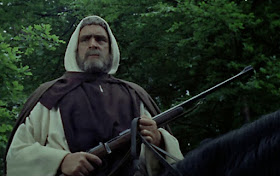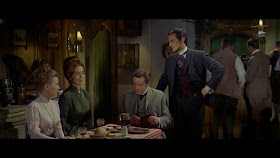Cabin Fever Remake (2016)
Dir. Travis Zariwny (Alias: Travis Z)
Written by Randy Pearlstein and Eli Roth
Starring Gage Golightly, Matthew Daddario, Samuel Davis, Nadine Crocker, Dustin Ingram
So there are a few problems here. The first is that CABIN FEVER (2002) --directorial debut of noted PIRANHA 3D supporting player Eli Roth-- is already a pretty shitty film. I know it has its defenders, but they’re wrong. It’s amateurishly made, tonally awkward, and aesthetically displeasing, while offering little tension, a lot of fratty sophomoric “humor,” and not really even that much gore when it comes down to it. Hence that old axiom, “if you like CABIN FEVER, you’re a piece of shit human being.” I think that was in Poor Richard’s Almanac but it might’ve been George Bernard Shaw, I can’t quite remember.
The second problem is that this remake somehow manages not to understand the few things that do work about CABIN FEVER 2002. I mean, it’s a shitty, stupid movie, but I’ll give it this: it feel uncompromised, like the finished result is exactly what former Howard Stern assistant Eli Roth had envisioned, the kind of movie he always wanted to see. Which kind of makes sense, considering he wrote the film (with then-college-roommate Randy Pearlstein) in 1995 -- this is exactly the sort of horseshit a 23-year-old frat boy horror fan would think was totally hilarious and boundary-pushing.* He’s wrong on both counts, but still, I’ll give him this: CABIN FEVER 2002 is a movie which is shooting for something specific, a kind of cringe-comedy misanthropy married with intentionally repellent body horror, and even if you don’t think it’s a very good version of either of those things, it’s hard to miss that there is, if nothing else, a distinct auteurial voice there. But somehow, that’s exactly what director Travis Z (wisely attempting to hide his identity with a fake last name) managed to do with his remake. Instead of realizing that the only thing that makes CABIN FEVER 2002 even marginally watchable is its unique sense of playfully hateful black comedy, Mr. Z approaches his version as a very straightforward, grim, shiny modern horror movie.
The third problem is that after already making the bad decision to remake CABIN FEVER and then making the subsequent bad decision to remake CABIN FEVER without the comedy, they then make the even more crippling decision to use the exact same screenplay. You know, the one which was made to be a comedy back in 2002. How, exactly, do you turn a comedy script into a typically glum modern studio remake? Well, by cutting out the punchlines, of course! Wikipedia claims that Mr. Z took the screenplay and simply cut it down from 142 pages to a mere 92 pages, removing the wackier parts and leaving only the connective material. That sound like a good idea?
The result is a movie which does, indeed, remove the fratty, campy humor of the original CABIN FEVER, and replaces it with… nothing. Nothing at all. Instead, it pretends that the original screenplay, with the majority but not quite all of its jokes hewed out, would work as a tense, serious horror movie, which it obviously does not, I mean come on, what the fuck were they thinking here? Removing the jokes just leaves scene after scene a baffling exercise in anti-narrative, as the script laboriously sets up jokes whose punchlines never arrive. As hour after ruinous hour roll by (the movie is somehow six minutes longer than the original CABIN FEVER, despite being 50 script pages shorter) you begin to almost feel pity for each new scene, as they lurch forward into the spotlight with a look of confused shame at their own tormented, meaningless half-life.
Oh, it looks nice, of course. Frankly it’s so easy these days to make a nice-looking movie that it’s almost refreshing when something looks noticeably incompetent. But no such luck here. Cinematographer Gavin Kelly (an impressive number of movies I’ve never heard of, and various episodes of American Horror Story) frames our story handsomely --if not especially stylishly-- and composer Kevin Riepl (Gears of War, CONTRACTED) fulfills his end of the bargain with an outrageously pushy score which all but climbs out of the screen with a gun and demands that you experience the tragedy of all this. The cast is game enough to treat this as if it deserved actual acting on some level, even if they’re the typical sampling of pretty bland twenty-somethings with some spray-sweat and carefully cultivated stubble in a vague gesture towards what people in Hollywood think reality looks like. The gore looks pretty utterly convincing, which does once or twice elicit a moment of genuine repulsion. Really, in every imaginable technical way, CABIN FEVER 2016 is at least the equal of its progenitor and frequently the clearly superior film.
But in every imaginable way which is actually important here, it’s a stunningly complete disaster. Twitchy Dustin Ingram (True Blood, Vinyl) may be a better actor than square-jawed lunk James DeBello (DETROIT ROCK CITY), but re-casting a role clearly written for an obnoxious bro with an abrasive hipster nerd is folly on a truly heroic scale. Presenting Roth’s comically stereotypical rednecks as serious, gritty realism is disastrous in a way which is hard to even describe. And reimagining Giuseppe Andrew’s (INDEPENDENCE DAY) oddball sheriff's deputy as a sexually aggressive woman (Louise Linton, RULES DON’T APPLY) would be definitively movie-killing, were the movie not already so dead as to have completely decayed and returned to the loam by the time she shows up.
That last change is explained by Mr. Z as a matter of artistic necessity: “there was no way for me to emulate Giuseppe’s performance,” he offers in an obsequious Entertainment Weekly interview before the film’s release. And of course, on the surface that makes sense: movies are by their very nature filled with the distinct and inimitable personality of the artists and technicians who make them, and you’ll never be able to exactly recreate those things, no matter how much you might like them. But, Z, movies are also a function of their actual structure! You can’t just randomly and radically alter key portions of the structure, altering their very fundamental purpose, and expect the house to still stand up. Imagine if someone remade PSYCHO and decided that because Tony Perkins’ neurotic oddness was impossible to recreate, they’d go the opposite route and cast Norman Bates as a WWE wrestler with a bald head, goatee, and face tattoo… do you think PSYCHO would still work, like at all?
Of course it wouldn’t. That’s the odd challenge you grapple with when faced with the prospect of a remake: you don’t want it to be exactly the same, because then there’d be no point (or at least, even less point), and no way to recapture that particular lightning in a bottle anyway. So instead, you want to make something distinctly your own. But you also have to identify what details of the original are fundamentally important to the thing working as a whole, and you have to make sure those survive, at least in some form, to provide the same structure. You start meddling with those --swapping them out, radically reshaping them, cutely inverting them-- and the whole thing comes crashing down in a heap, like it does here about as spectacularly as I’ve ever witnessed.
To put it simply: Mr. Z thinks that replacing the original movie’s air rifle with a high-powered semi-automatic weapon would not affect the reaction of characters who are accidentally nearly shot significantly enough to warrant new dialogue. That pretty much sums up the entire experience of watching the movie: first, it’s an exact copy of a scene in another movie, second, the original idea was plenty dumb already, and third, they then randomly and bafflingly change one detail which so totally negates the meaning of the original scene that it starts to become a bizarre exercise in impenetrable surrealism. Almost shooting your friends with an air rifle makes you an irresponsible idiot. Almost shooting your friends with a high-powered automatic rifle makes you a dangerous criminal. The idea that you could use the same dialogue in both situations is so utterly demented that I’m very nearly tempted to wonder if this is actually a stealth art movie, some kind of crazy experiment in narrative decontextualization that got erroneously advertised as a cheapie money-grab genre flick.
But then I remember that Eli Roth produced it too, so probably not. I suspect instead that Mr. Roth is so convinced of the inherent greatness of his work that it never occurred to him that remaking --in any form-- could result in anything but further greatness. Fortunately it’s now stunningly evident that neither assumption was correct. But it ended up being a net gain for the world, for, unbeknownst to its makers, CABIN FEVER 2016 turned out to be an absolutely essential tool to examine what a film looks like when it takes identical material and sturdy production and manages to make every single wrong artistic choice imaginable. It’s so perfectly wretched as to be required viewing for anyone seriously interested in filmmaking. As a movie, it’s horrible. But as an autopsy, it’s fascinating.
*So of course Quentin Tarantino subsequently called it his favorite modern film and dubbed Roth “the future of horror.” Thank God he turned out to be so wrong about that.
CHAINSAWNUKAH 2016 CHECKLIST!
Good Kill Hunting
TAGLINE
|
You Can’t Hide From What’s Inside, which just has to be a lyric from a Tears For Fears song, right?
|
TITLE ACCURACY
|
It is a remake of Cabin Fever. But ironically, fever is not one of symptoms depicted here.
|
LITERARY ADAPTATION?
|
No
|
SEQUEL?
|
No
|
REMAKE?
|
Yup, and how
|
COUNTRY OF ORIGIN
|
USA
|
HORROR SUB-GENRE
|
Body Horror
|
SLUMMING A-LISTER?
|
None
|
BELOVED HORROR ICON?
|
None
|
NUDITY?
|
Yup, several fairly graphic sex scenes and one grossout bloody nude scenes too
|
SEXUAL ASSAULT?
|
No
|
WHEN ANIMALS ATTACK!
|
Cabin Fevere’d Dogs menance our heroes on several occasions
|
GHOST/ ZOMBIE / HAUNTED BUILDING?
|
No
|
POSSESSION?
|
No
|
CREEPY DOLLS?
|
No
|
EVIL CULT?
|
No
|
MADNESS?
|
No
|
TRANSMOGRIFICATION?
|
Normal humans to piles of bloody goo
|
VOYEURISM?
|
None
|
MORAL OF THE STORY
|
The only thing worse than an Eli Roth movie is someone else making an Eli Roth movie.
|














